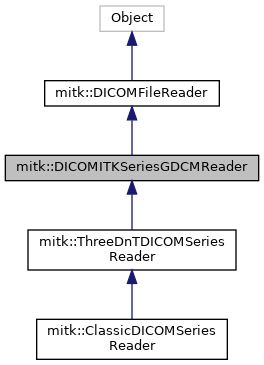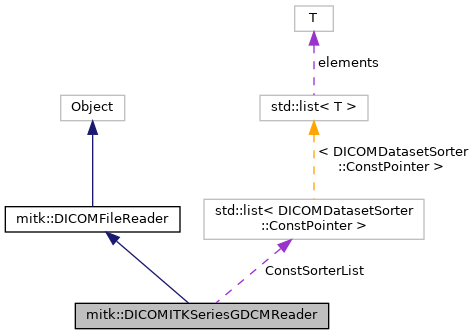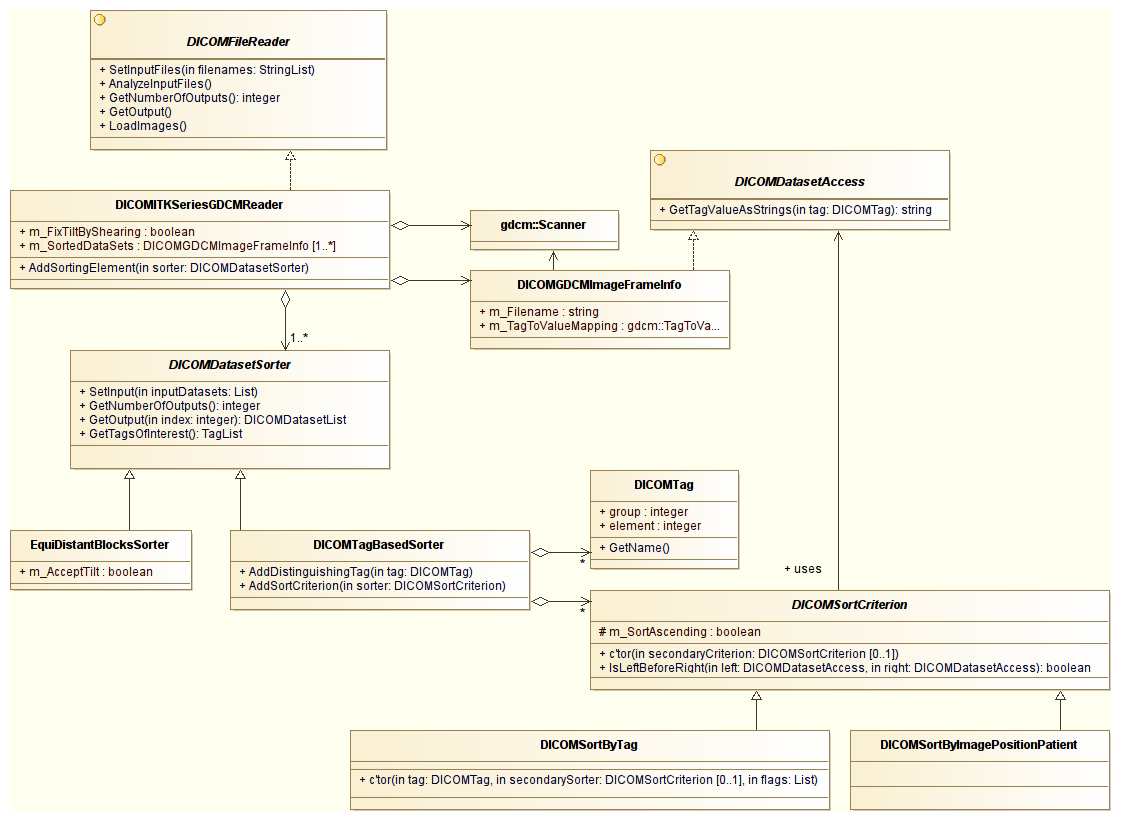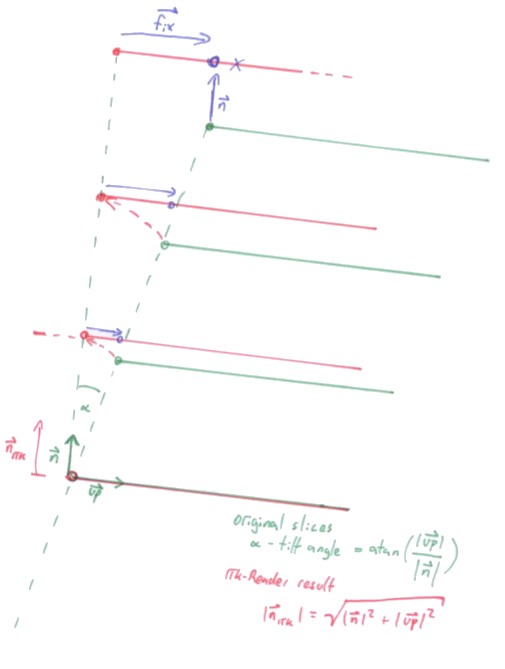Flexible reader based on itk::ImageSeriesReader and GDCM, for single-slice modalities like CT, MR, PET, CR, etc. More...
#include <mitkDICOMITKSeriesGDCMReader.h>


Public Member Functions | |
| mitkClassMacro (DICOMITKSeriesGDCMReader, DICOMFileReader) | |
| mitkCloneMacro (DICOMITKSeriesGDCMReader) | |
| mitkNewMacro1Param (DICOMITKSeriesGDCMReader, unsigned int) | |
| mitkNewMacro2Param (DICOMITKSeriesGDCMReader, unsigned int, bool) | |
| void | AnalyzeInputFiles () override |
| Runs the sorting / splitting process described in Loading strategy. Method required by DICOMFileReader. More... | |
| bool | LoadImages () override |
| Loads images using itk::ImageSeriesReader, potentially applies shearing to correct gantry tilt. More... | |
| bool | CanHandleFile (const std::string &filename) override |
| Indicate whether this reader can handle given file. More... | |
| virtual void | AddSortingElement (DICOMDatasetSorter *sorter, bool atFront=false) |
| Add an element to the sorting procedure described in Loading strategy. More... | |
| ConstSorterList | GetFreelyConfiguredSortingElements () const |
| void | SetFixTiltByShearing (bool on) |
| Controls whether to "fix" tilted acquisitions by shearing the output (see Gantry tilt handling). More... | |
| bool | GetFixTiltByShearing () const |
| void | SetAcceptTwoSlicesGroups (bool accept) const |
| Controls whether groups of only two images are accepted when ensuring consecutive slices via EquiDistantBlocksSorter. More... | |
| bool | GetAcceptTwoSlicesGroups () const |
| void | SetToleratedOriginOffsetToAdaptive (double fractionOfInterSliceDistanct=0.3) const |
| See Forced Configuration. More... | |
| void | SetToleratedOriginOffset (double millimeters=0.005) const |
| See Forced Configuration. More... | |
| void | SetSimpleVolumeReading (bool read) |
| Ignore all dicom tags that are non-essential for simple 3D volume import. More... | |
| bool | GetSimpleVolumeReading () |
| Ignore all dicom tags that are non-essential for simple 3D volume import. More... | |
| double | GetToleratedOriginError () const |
| bool | IsToleratedOriginOffsetAbsolute () const |
| double | GetDecimalPlacesForOrientation () const |
| bool | operator== (const DICOMFileReader &other) const override |
| DICOMTagPathList | GetTagsOfInterest () const override |
 Public Member Functions inherited from mitk::DICOMFileReader Public Member Functions inherited from mitk::DICOMFileReader | |
| mitkClassMacroItkParent (DICOMFileReader, itk::Object) | |
| void | SetInputFiles (const StringList &filenames) |
| This input files. More... | |
| const StringList & | GetInputFiles () const |
| This input files. More... | |
| unsigned int | GetNumberOfOutputs () const |
| Number of outputs, only meaningful after calling AnalyzeInputFiles() More... | |
| const DICOMImageBlockDescriptor & | GetOutput (unsigned int index) const |
| Individual outputs, only meaningful after calling AnalyzeInputFiles(). More... | |
| void | SetConfigurationLabel (const std::string &) |
| Short label/name to describe this reader. More... | |
| std::string | GetConfigurationLabel () const |
| Short label/name to describe this reader. More... | |
| void | SetConfigurationDescription (const std::string &) |
| One-sentence description of the reader's loading "strategy". More... | |
| std::string | GetConfigurationDescription () const |
| One-sentence description of the reader's loading "strategy". More... | |
| void | PrintConfiguration (std::ostream &os) const |
| Print configuration description to given stream, for human reader. More... | |
| void | PrintOutputs (std::ostream &os, bool filenameDetails=false) const |
| Print output description to given stream, for human reader. More... | |
| virtual void | SetAdditionalTagsOfInterest (const AdditionalTagsMapType &tagList) |
| Set a list of DICOMTagPaths that specify all DICOM-Tags that will be copied into the property of the mitk::Image. More... | |
| virtual void | SetTagLookupTableToPropertyFunctor (mitk::DICOMImageBlockDescriptor::TagLookupTableToPropertyFunctor functor) |
| Set a functor that defines how the slice-specific tag-values are stored in a Property. More... | |
Static Public Member Functions | |
| static Pointer | New () |
| static int | GetDefaultDecimalPlacesForOrientation () |
| static bool | GetDefaultSimpleVolumeImport () |
| static bool | GetDefaultFixTiltByShearing () |
 Static Public Member Functions inherited from mitk::DICOMFileReader Static Public Member Functions inherited from mitk::DICOMFileReader | |
| static bool | IsDICOM (const std::string &filename) |
| Test whether a file is DICOM at all. More... | |
Public Attributes | |
| const typedef std::list< DICOMDatasetSorter::ConstPointer > | ConstSorterList |
Protected Types | |
| typedef std::vector< DICOMDatasetAccessingImageFrameList > | SortingBlockList |
Protected Member Functions | |
| void | InternalPrintConfiguration (std::ostream &os) const override |
| Configuration description for human reader, to be implemented by sub-classes. More... | |
| void | PushLocale () const |
| Remember current locale on stack, activate "C" locale. "C" locale is required for correct parsing of numbers by itk::ImageSeriesReader. More... | |
| void | PopLocale () const |
| Activate last remembered locale from locale stack "C" locale is required for correct parsing of numbers by itk::ImageSeriesReader. More... | |
| DICOMITKSeriesGDCMReader (unsigned int decimalPlacesForOrientation=m_DefaultDecimalPlacesForOrientation, bool simpleVolumeImport=m_DefaultSimpleVolumeImport) | |
| ~DICOMITKSeriesGDCMReader () override | |
| DICOMITKSeriesGDCMReader (const DICOMITKSeriesGDCMReader &other) | |
| DICOMITKSeriesGDCMReader & | operator= (const DICOMITKSeriesGDCMReader &other) |
| virtual SortingBlockList | Condense3DBlocks (SortingBlockList &resultOf3DGrouping) |
| "Hook" for sub-classes, see Sub-classes can condense multiple blocks into a single larger block More... | |
| virtual DICOMTagCache::Pointer | GetTagCache () const |
| void | SetTagCache (const DICOMTagCache::Pointer &) override |
| A way to provide external knowledge about files and tag values is appreciated. More... | |
| virtual bool | LoadMitkImageForOutput (unsigned int o) |
| Loads the mitk::Image by means of an itk::ImageSeriesReader. More... | |
| virtual bool | LoadMitkImageForImageBlockDescriptor (DICOMImageBlockDescriptor &block) const |
 Protected Member Functions inherited from mitk::DICOMFileReader Protected Member Functions inherited from mitk::DICOMFileReader | |
| DICOMFileReader () | |
| ~DICOMFileReader () override | |
| DICOMFileReader (const DICOMFileReader &other) | |
| DICOMFileReader & | operator= (const DICOMFileReader &other) |
| void | ClearOutputs () |
| void | SetNumberOfOutputs (unsigned int numberOfOutputs) |
| void | SetOutput (unsigned int index, const DICOMImageBlockDescriptor &output) |
| DICOMImageBlockDescriptor & | InternalGetOutput (unsigned int index) |
| non-const access to the DICOMImageBlockDescriptor More... | |
| virtual AdditionalTagsMapType | GetAdditionalTagsOfInterest () const |
| mitk::DICOMImageBlockDescriptor::TagLookupTableToPropertyFunctor | GetTagLookupTableToPropertyFunctor () const |
Static Protected Member Functions | |
| static std::string | GetActiveLocale () |
| Return active C locale. More... | |
| static SortingBlockList | InternalExecuteSortingStep (unsigned int sortingStepIndex, const DICOMDatasetSorter::Pointer &sorter, const SortingBlockList &input) |
| Sorting step as described in Loading strategy. More... | |
| static ReaderImplementationLevel | GetReaderImplementationLevel (const std::string sopClassUID) |
| Describe this reader's confidence for given SOP class UID. More... | |
Protected Attributes | |
| bool | m_FixTiltByShearing |
| bool | m_SimpleVolumeReading |
| mitk::EquiDistantBlocksSorter::Pointer | m_EquiDistantBlocksSorter |
| mitk::NormalDirectionConsistencySorter::Pointer | m_NormalDirectionConsistencySorter |
Static Protected Attributes | |
| const static int | m_DefaultDecimalPlacesForOrientation |
| const static bool | m_DefaultSimpleVolumeImport |
| const static bool | m_DefaultFixTiltByShearing |
Additional Inherited Members | |
 Public Types inherited from mitk::DICOMFileReader Public Types inherited from mitk::DICOMFileReader | |
| typedef DICOMImageBlockDescriptor::AdditionalTagsMapType | AdditionalTagsMapType |
Detailed Description
Flexible reader based on itk::ImageSeriesReader and GDCM, for single-slice modalities like CT, MR, PET, CR, etc.
Implements the loading processed as structured by DICOMFileReader offers configuration of its loading strategy.
Documentation sections:
- Loading strategy
- Forced Configuration
- User Configuration
- Gantry tilt handling
- Testing
- Class internals
Loading strategy
The set of input files is processed by a number of DICOMDatasetSorter objects which may do two sort of things:
- split a list of input frames into multiple lists, based on DICOM tags such as "Rows", "Columns", which cannot be mixed within a single mitk::Image
- sort the frames within the input lists, based on the values of DICOM tags such as "Image Position Patient"
When the DICOMITKSeriesGDCMReader is configured with DICOMDatasetSorters, the list of input files is processed as follows:
- build an initial set of output groups, simply by grouping all input files.
- for each configured DICOMDatasetSorter, process:
- for each output group:
- set this group's files as input to the sorter
- let the sorter sort (and split)
- integrate the sorter's output groups with our own output groups
- for each output group:
Forced Configuration
In all cases, the reader will add two DICOMDatasetSorter objects that are required to load mitk::Images properly via itk::ImageSeriesReader:
- As a first step, the input files will be split into groups that are not compatible because they differ in essential aspects:
- (0028,0010) Number of Rows
- (0028,0011) Number of Columns
- (0028,0030) Pixel Spacing
- (0018,1164) Imager Pixel Spacing
- (0020,0037) Image Orientation (Patient)
- (0018,0050) Slice Thickness
- (0028,0008) Number of Frames
- As are two forced last steps:
- There will always be an instance of EquiDistantBlocksSorter, which ensures that there is an equal distance between all the frames of an Image. This is required to achieve correct geometrical positions in the mitk::Image, i.e. it is essential to be able to make measurements in images.
- whether or not the distance is required to be orthogonal to the image planes is configured by SetFixTiltByShearing().
- during this check, we need to tolerate some minor errors in documented vs. calculated image origins. The amount of tolerance can be adjusted by SetToleratedOriginOffset() and SetToleratedOriginOffsetToAdaptive(). Please see EquiDistantBlocksSorter for more details. The default should be good for most cases.
- There is always an instance of NormalDirectionConsistencySorter, which makes the order of images go along the image normals (see NormalDirectionConsistencySorter)
- There will always be an instance of EquiDistantBlocksSorter, which ensures that there is an equal distance between all the frames of an Image. This is required to achieve correct geometrical positions in the mitk::Image, i.e. it is essential to be able to make measurements in images.
User Configuration
The user of this class can add more sorting steps (similar to the one described in above section) by calling AddSortingElement().
Usually, an application will add sorting by "Image Position Patient", by "Instance Number", and by other relevant tags here.
Gantry tilt handling
When CT gantry tilt is used, the gantry plane (= X-Ray source and detector ring) and the vertical plane do not align anymore. This scanner feature is used for example to reduce metal artifacts (e.g. Lee C , Evaluation of Using CT Gantry Tilt Scan on Head and Neck Cancer Patients with Dental Structure: Scans Show Less Metal Artifacts. Presented at: Radiological Society of North America 2011 Scientific Assembly and Annual Meeting; November 27- December 2, 2011 Chicago IL.).
The acquired planes of such CT series do not match the expectations of a orthogonal geometry in mitk::Image: if you stack the slices, they show a small shift along the Y axis:
without tilt with tilt
|||||| //////
|||||| //////
-- |||||| --------- ////// -------- table orientation
|||||| //////
|||||| //////
Stacked slices:
without tilt with tilt
-------------- --------------
-------------- --------------
-------------- --------------
-------------- --------------
-------------- --------------As such gemetries do not "work" in conjunction with mitk::Image, DICOMITKSeriesGDCMReader is able to perform a correction for such series. Whether or not such correction should be attempted is controlled by SetFixTiltByShearing(), the default being correction. For details, see "Internals" below.
Testing
A number of tests is implemented in module DICOMTesting, which is documented at MITK DICOM testing.
Class internals
Internally, the class is based on GDCM and it depends heavily on the gdcm::Scanner class.
Since the sorting elements (see DICOMDatasetSorter and DICOMSortCriterion) can access tags only via the DICOMDatasetAccess interface, BUT DICOMITKSeriesGDCMReader holds a list of more specific classes DICOMGDCMImageFrameInfo, we must convert between the two types sometimes. This explains the methods ToDICOMDatasetList(), FromDICOMDatasetList().
The intermediate result of all the sorting efforts is held in m_SortingResultInProgress, which is modified through InternalExecuteSortingStep().
Overview of related classes
The following diagram gives an overview of the related classes:

Details about the tilt correction
The gantry tilt "correction" algorithm fixes two errors introduced by ITK's ImageSeriesReader:
- the plane shift that is ignored by ITK's reader is recreated by applying a shearing transformation using itk::ResampleFilter.
- the spacing is corrected (it is calculated by ITK's reader from the distance between two origins, which is NOT the slice distance in this special case)
Both errors are introduced in itkImageSeriesReader.txx (ImageSeriesReader<TOutputImage>::GenerateOutputInformation(void)), lines 176 to 245 (as of ITK 3.20)
For the correction, we examine two consecutive slices of a series, both described as a pair (origin/orientation):
- we calculate if the first origin is on a line along the normal of the second slice
- if this is not the case, the geometry will not fit a normal mitk::Image/mitk::Geometry3D
- we then project the second origin into the first slice's coordinate system to quantify the shift
- both is done in class GantryTiltInformation with quite some comments.
The geometry of image stacks with tilted geometries is illustrated below:
- green: the DICOM images as described by their tags: origin as a point with the line indicating the orientation
- red: the output of ITK ImageSeriesReader: wrong, larger spacing, no tilt
- blue: how much a shear must correct

Sub-classes can condense multiple blocks into a single larger block
The sorting/splitting process described above is helpful for at least two more DICOM readers, which either try to load 3D+t images or which load diffusion data.
In both cases, a single pixel of the mitk::Image is made up of multiple values, in one case values over time, in the other case multiple measurements of a single point.
The specialized readers for these cases (e.g. ThreeDnTDICOMSeriesReader) can reuse most of the methods in DICOMITKSeriesGDCMReader, except that they need an extra step after the usual sorting, in which they can merge already grouped 3D blocks. What blocks are merged depends on the specialized reader's understanding of these images. To allow for such merging, a method Condense3DBlocks() is called as an absolute last step of AnalyzeInputFiles(). Given this, a sub-class could implement only LoadImages() and Condense3DBlocks() instead repeating most of AnalyzeInputFiles().
Definition at line 190 of file mitkDICOMITKSeriesGDCMReader.h.
Member Typedef Documentation
◆ SortingBlockList
|
protected |
Definition at line 313 of file mitkDICOMITKSeriesGDCMReader.h.
Constructor & Destructor Documentation
◆ DICOMITKSeriesGDCMReader() [1/2]
|
protected |
◆ ~DICOMITKSeriesGDCMReader()
|
overrideprotected |
◆ DICOMITKSeriesGDCMReader() [2/2]
|
protected |
Member Function Documentation
◆ AddSortingElement()
|
virtual |
Add an element to the sorting procedure described in Loading strategy.
◆ AnalyzeInputFiles()
|
overridevirtual |
Runs the sorting / splitting process described in Loading strategy. Method required by DICOMFileReader.
Implements mitk::DICOMFileReader.
◆ CanHandleFile()
|
overridevirtual |
Indicate whether this reader can handle given file.
Implements mitk::DICOMFileReader.
◆ Condense3DBlocks()
|
protectedvirtual |
"Hook" for sub-classes, see Sub-classes can condense multiple blocks into a single larger block
- Returns
- REMAINING blocks
Reimplemented in mitk::ThreeDnTDICOMSeriesReader.
◆ GetAcceptTwoSlicesGroups()
| bool mitk::DICOMITKSeriesGDCMReader::GetAcceptTwoSlicesGroups | ( | ) | const |
◆ GetActiveLocale()
|
staticprotected |
Return active C locale.
◆ GetDecimalPlacesForOrientation()
| double mitk::DICOMITKSeriesGDCMReader::GetDecimalPlacesForOrientation | ( | ) | const |
◆ GetDefaultDecimalPlacesForOrientation()
|
inlinestatic |
Definition at line 271 of file mitkDICOMITKSeriesGDCMReader.h.
◆ GetDefaultFixTiltByShearing()
|
inlinestatic |
Definition at line 281 of file mitkDICOMITKSeriesGDCMReader.h.
◆ GetDefaultSimpleVolumeImport()
|
inlinestatic |
Definition at line 276 of file mitkDICOMITKSeriesGDCMReader.h.
◆ GetFixTiltByShearing()
| bool mitk::DICOMITKSeriesGDCMReader::GetFixTiltByShearing | ( | ) | const |
◆ GetFreelyConfiguredSortingElements()
| ConstSorterList mitk::DICOMITKSeriesGDCMReader::GetFreelyConfiguredSortingElements | ( | ) | const |
◆ GetReaderImplementationLevel()
|
staticprotected |
Describe this reader's confidence for given SOP class UID.
◆ GetSimpleVolumeReading()
|
inline |
Ignore all dicom tags that are non-essential for simple 3D volume import.
Definition at line 257 of file mitkDICOMITKSeriesGDCMReader.h.
◆ GetTagCache()
|
protectedvirtual |
◆ GetTagsOfInterest()
|
overridevirtual |
Implements mitk::DICOMFileReader.
◆ GetToleratedOriginError()
| double mitk::DICOMITKSeriesGDCMReader::GetToleratedOriginError | ( | ) | const |
◆ InternalExecuteSortingStep()
|
staticprotected |
Sorting step as described in Loading strategy.
◆ InternalPrintConfiguration()
|
overrideprotectedvirtual |
Configuration description for human reader, to be implemented by sub-classes.
Implements mitk::DICOMFileReader.
◆ IsToleratedOriginOffsetAbsolute()
| bool mitk::DICOMITKSeriesGDCMReader::IsToleratedOriginOffsetAbsolute | ( | ) | const |
◆ LoadImages()
|
overridevirtual |
Loads images using itk::ImageSeriesReader, potentially applies shearing to correct gantry tilt.
Implements mitk::DICOMFileReader.
Reimplemented in mitk::ThreeDnTDICOMSeriesReader.
◆ LoadMitkImageForImageBlockDescriptor()
|
protectedvirtual |
Reimplemented in mitk::ThreeDnTDICOMSeriesReader.
◆ LoadMitkImageForOutput()
|
protectedvirtual |
Loads the mitk::Image by means of an itk::ImageSeriesReader.
◆ mitkClassMacro()
| mitk::DICOMITKSeriesGDCMReader::mitkClassMacro | ( | DICOMITKSeriesGDCMReader | , |
| DICOMFileReader | |||
| ) |
◆ mitkCloneMacro()
| mitk::DICOMITKSeriesGDCMReader::mitkCloneMacro | ( | DICOMITKSeriesGDCMReader | ) |
◆ mitkNewMacro1Param()
| mitk::DICOMITKSeriesGDCMReader::mitkNewMacro1Param | ( | DICOMITKSeriesGDCMReader | , |
| unsigned int | |||
| ) |
◆ mitkNewMacro2Param()
| mitk::DICOMITKSeriesGDCMReader::mitkNewMacro2Param | ( | DICOMITKSeriesGDCMReader | , |
| unsigned int | , | ||
| bool | |||
| ) |
◆ New()
|
static |
◆ operator=()
|
protected |
◆ operator==()
|
overridevirtual |
Implements mitk::DICOMFileReader.
Reimplemented in mitk::ThreeDnTDICOMSeriesReader.
◆ PopLocale()
|
protected |
Activate last remembered locale from locale stack "C" locale is required for correct parsing of numbers by itk::ImageSeriesReader.
◆ PushLocale()
|
protected |
Remember current locale on stack, activate "C" locale. "C" locale is required for correct parsing of numbers by itk::ImageSeriesReader.
◆ SetAcceptTwoSlicesGroups()
| void mitk::DICOMITKSeriesGDCMReader::SetAcceptTwoSlicesGroups | ( | bool | accept | ) | const |
Controls whether groups of only two images are accepted when ensuring consecutive slices via EquiDistantBlocksSorter.
◆ SetFixTiltByShearing()
| void mitk::DICOMITKSeriesGDCMReader::SetFixTiltByShearing | ( | bool | on | ) |
Controls whether to "fix" tilted acquisitions by shearing the output (see Gantry tilt handling).
◆ SetSimpleVolumeReading()
|
inline |
Ignore all dicom tags that are non-essential for simple 3D volume import.
Definition at line 249 of file mitkDICOMITKSeriesGDCMReader.h.
◆ SetTagCache()
|
overrideprotectedvirtual |
A way to provide external knowledge about files and tag values is appreciated.
Implements mitk::DICOMFileReader.
◆ SetToleratedOriginOffset()
| void mitk::DICOMITKSeriesGDCMReader::SetToleratedOriginOffset | ( | double | millimeters = 0.005 | ) | const |
See Forced Configuration.
◆ SetToleratedOriginOffsetToAdaptive()
| void mitk::DICOMITKSeriesGDCMReader::SetToleratedOriginOffsetToAdaptive | ( | double | fractionOfInterSliceDistanct = 0.3 | ) | const |
See Forced Configuration.
Member Data Documentation
◆ ConstSorterList
| const typedef std::list<DICOMDatasetSorter::ConstPointer> mitk::DICOMITKSeriesGDCMReader::ConstSorterList |
Definition at line 220 of file mitkDICOMITKSeriesGDCMReader.h.
◆ m_DefaultDecimalPlacesForOrientation
|
staticprotected |
Definition at line 303 of file mitkDICOMITKSeriesGDCMReader.h.
◆ m_DefaultFixTiltByShearing
|
staticprotected |
Definition at line 305 of file mitkDICOMITKSeriesGDCMReader.h.
◆ m_DefaultSimpleVolumeImport
|
staticprotected |
Definition at line 304 of file mitkDICOMITKSeriesGDCMReader.h.
◆ m_EquiDistantBlocksSorter
|
protected |
Definition at line 358 of file mitkDICOMITKSeriesGDCMReader.h.
◆ m_FixTiltByShearing
|
protected |
Definition at line 344 of file mitkDICOMITKSeriesGDCMReader.h.
◆ m_NormalDirectionConsistencySorter
|
protected |
Definition at line 360 of file mitkDICOMITKSeriesGDCMReader.h.
◆ m_SimpleVolumeReading
|
protected |
Definition at line 346 of file mitkDICOMITKSeriesGDCMReader.h.
The documentation for this class was generated from the following file:
